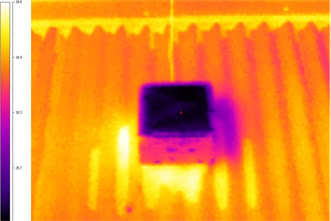SYDNEY, June 2, 2015 — A potential new roofing material stays cooler than the ambient air temperature, even under the midsummer Australian sun.
Comprising a coated polymer stack on a silver thin film, the surface exhibited nearly 100 percent solar reflectance and thermal emittance at IR wavelengths from 7.9 to 13 μm, according to researchers at the University of Technology Sydney.
Even white roofs absorb enough sunlight to warm up by 9 °C to 12 °C, said emeritus professor Geoff Smith.
"This new surface, however, stayed 11 degrees or more colder than an existing state-of-the-art white roof nearby because it absorbs only 3 percent of incident sunlight while simultaneously strongly radiating heat at IR wavelengths that are not absorbed by the atmosphere."

An IR image shows the temperature difference between the new surface (center) and an existing cool roof used in testing. Courtesy of the University of Technology Sydney.
The test roof was placed on top of the university's Faculty of Science building with a clear view of the sky and no shadowing. Data was collected for an unprotected new surface and one aged over several days in a polluted outdoor summer environment for assessment of the impact of the build-up of dust and grime. The surface maintained its high performance in all conditions, Smith said.
"Extensive dew formation is inevitable for a supercool roof and dew drops precipitate dirt," he said. "This roof site being 25 m above a busy city transit road was a stern test. Results show that excellent thermal performance can be maintained."
The materials used in the demonstration are commercially available and potentially suited to use on basic roofing, Smith said.
"Cool roofing reduces the severity of the urban heat island problem in towns and cities and helps eliminate peak power demand problems from the operation of many air conditioners," Smith said. "The added feedback benefits from cool roofs are not yet widely appreciated, but recent reports have shown they are substantial. Examples include ventilation with cooler air and higher performance of rooftop air-conditioning installations."
Funding came from an Australian Research Council Discovery Project grant.
The research was published in Advanced Science (doi: 10.1002/advs.201500119 [open access]).
For more information, visit www.uts.edu.au.